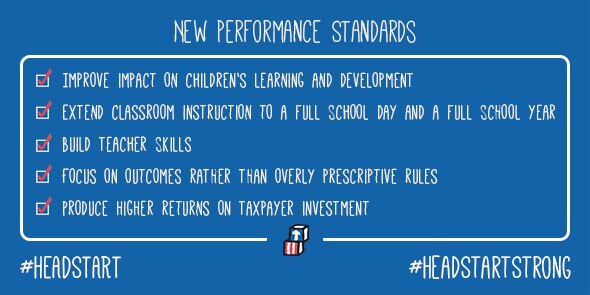On Tuesday, the U.S. Department of Health and Human Services’ (HHS) Administration for Children and Families released the new, improved, and long-awaited Head Start Performance Standards in a (NPRM). This is the first comprehensive overhaul of the standards since they were first published in 1975. Both the early education landscape and our knowledge of the science of early learning have changed dramatically in the last 40 years, and understandably, many of the performance standards were in need of an update.HHS was required to update the standards in 2007 to align with the most recent Head Start reauthorization. The Head Start community has been awaiting changes for some time, and many advocates of Head Start reform have been calling on the Department to streamline the standards and shift the focus from compliance to quality (examples, and ). While it may have taken HHS eight years to revise the standards, it appears that the wait was worthwhile. On Tuesday, HHS presented more than just an updated list of standards, they presented a detailed “.”Head Start is the nation’s largest pre-K program and it has come under intense scrutiny since the Head Start Impact Study found that some Head Start children do not experience the significant and lasting achievement gains that children in other experience.

In response, advocates, policymakers, and researchers have been focused on improving the quality of Head Start so that all children leave the program prepared to succeed in school and in life. The proposed performance standards reflect the latest research on early education and Head Start in particular, and would help ensure that all Head Start programs produce the best possible outcomes. Here are five changes to the standards that stood out to us:1.
Office Of Head Start Performance Standards
Moving to full-day and full-year programs. Perhaps the most significant change in the proposed performance standards is the increase in minimum program hours. Currently, Head Start centers must provide services for at least 3.5 hours per day and 128 days per year. The new proposed minimum is 6 hours per day and 180 days per year. This new requirement would more than double the amount of time that hundreds of thousands of Head Start children spend in the classroom, increasing their opportunities for high-quality interactions with their teachers and peers.

Research indicates that full-day and full-year programs are associated with greater. In half-day programs, there's simply not enough time to allow for free choice, outside play, socialization, and other activities that support literacy, early math, and early science learning.

The minimum hours proposed reflect the length of other that produce more consistent results than Head Start.This is also the most expensive change in the proposed standards. HHS has estimated that transitioning all programs to full-day and full-year would cost approximately $1 billion. Back in February, the President’s asked Congress for this funding to lengthen the Head Start day and year. It’s unclear how HHS would implement this change without substantial funding from Congress.
If this change does go into effect, HHS says that programs would have at least one full year to transition to the new dosage requirements.2. Removing overly burdensome and/or redundant requirements. According to HHS officials, Head Start currently has 1,400 performance standards (others have suggested that the number is ). HHS has reorganized, removed, and updated these standards to reduce the burden on providers, limit “micromanaging”, shifting Head Start from a “compliance-oriented culture to an outcomes-focused one.”For instance, under the proposed standards, programs would no longer need to establish a parent committee if they feel this hasn’t been an effective way to engage parents. Parent engagement would continue to be a key component of Head Start, but the federal government will no longer dictate which model of parent engagement centers need to use. HHS wants to give providers more flexibility to better meet the specific needs of the children and families served by their individual Head Start programs.These new standards are also an attempt to “make Head Start more approachable for potential grantees.” The Designation Renewal System (also known as recompetition) allows for new grantees to compete to replace lower-performing programs but it has been.3. Limiting suspension and prohibiting expulsion.
Last year, the pre-K data collection conducted by the Department of Education’s revealed a disturbing trend: African American students in public pre-K programs were being suspended and even expelled at a much higher rate than their white peers.